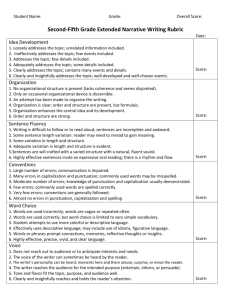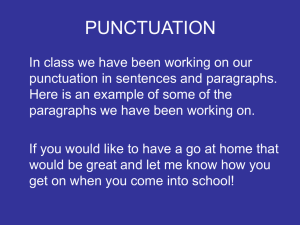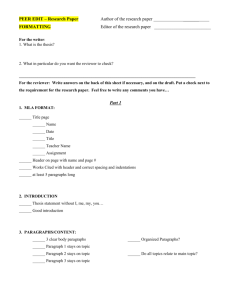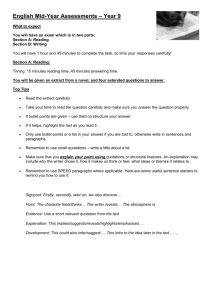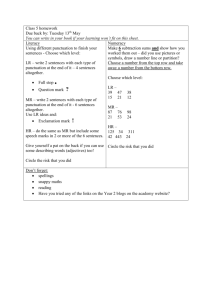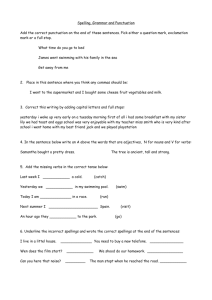Accuplacer_-_Writing_Chart - Cherry Creek School District
advertisement
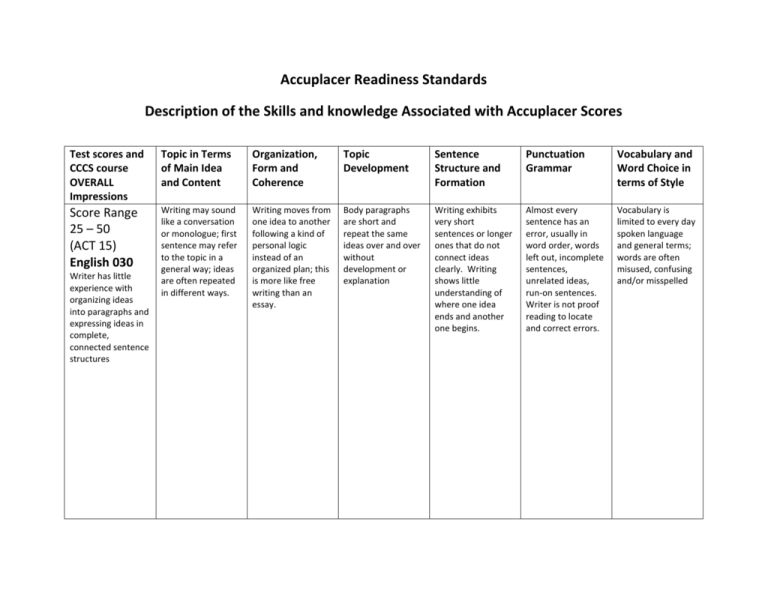
Accuplacer Readiness Standards Description of the Skills and knowledge Associated with Accuplacer Scores Test scores and CCCS course OVERALL Impressions Topic in Terms of Main Idea and Content Organization, Form and Coherence Topic Development Sentence Structure and Formation Punctuation Grammar Vocabulary and Word Choice in terms of Style Score Range 25 – 50 (ACT 15) English 030 Writing may sound like a conversation or monologue; first sentence may refer to the topic in a general way; ideas are often repeated in different ways. Writing moves from one idea to another following a kind of personal logic instead of an organized plan; this is more like free writing than an essay. Body paragraphs are short and repeat the same ideas over and over without development or explanation Writing exhibits very short sentences or longer ones that do not connect ideas clearly. Writing shows little understanding of where one idea ends and another one begins. Almost every sentence has an error, usually in word order, words left out, incomplete sentences, unrelated ideas, run-on sentences. Writer is not proof reading to locate and correct errors. Vocabulary is limited to every day spoken language and general terms; words are often misused, confusing and/or misspelled Writer has little experience with organizing ideas into paragraphs and expressing ideas in complete, connected sentence structures Test scores and CCCS course OVERALL Impressions Topic in Terms of Main Idea and Content Organization, Form and Coherence Topic Development Sentence Structure and Formation Punctuation Grammar Vocabulary and Word Choice in terms of Style Score Range 50 – 69 (ACT 16) English 060 Writes about assigned topic but main idea may not be clear and supporting points are loosely related to topic. Writing is not usually guided by a conscious plan and often seems choppy to the reader; often no closing sentence is present Body paragraphs may have too many ideas statements and little development or may be very short, even on sentence Writer usually writes in complete sentences, but ideas are not always connected logically and smoothly. Most sentences may be simple; writer does not use sentence types consciously Writing exhibits some error in punctuation, subject-verb agreement; incomplete sentences; pronoun references and confusing words. Vocabulary is a combination of every day spoken language, some general terms, and some language that is more precise. Writer does not take risks with language; works are sometimes misused, confusing or misspelled Writer has limited experience composing short essays. Some are developed with examples and explanation, but writing may be choppy. Writer usually writes in complete sentences, but does not show conscious use of various patterns. Test scores and CCCS course OVERALL Impressions Topic in Terms of Main Idea and Content Organization, Form and Coherence Topic Development Sentence Structure and Formation Punctuation Grammar Vocabulary and Word Choice in terms of Style Score Range 70 – 95 (ACT 17) English 090 Main idea is stated clearly but may be too general to sum up the supporting points of the essay; supporting points are related to topic. Overall organization is logical, but ideas are often not connected within and between paragraphs; a concluding sentence is usually present but may simply repeat the main idea without further comment Body paragraphs typically fall into 2 categories: those with clearly stated main ideas (topic sentences) but not smooth transitions or those with more general topic sentences include interesting examples. A variety of sentence types are present and are complete 70% of the time, ideas are logically though sometimes with overt transitions For the most part, commas and end marks are used correctly. Writing may show experimentation with semicolon, dash, colon, parentheses, quotation marks and ellipsis. Some verb tense shifts and pronoun agreement references are confusing. Two scenarios are most common: one writer may need to take more risks with language to develop a variety of styles for difference purposes and audiences; another writer who is experimenting with language and style needs to work on conveying precise meaning Writer has some experience with essay writing, paragraph development, organization, and sentence patterns. Writer is beginning to experiment with writing for difference purposes and audiences. Test scores and CCCS course OVERALL Impressions Topic in Terms of Main Idea and Content Organization, Form and Coherence Topic Development Sentence Structure and Formation Punctuation Grammar Vocabulary and Word Choice in terms of Style Score Range 95 and up (ACT 18) English 121 Delete a clause or sentence because it is obviously irrelevant to the essay Identify the basic purpose or role a specified phrase or sentence Select the most logical place to add a sentence in a paragraph Develop ideas by using some specific reasons, details and examples Show movement between general and specific ideas and examples Determine the need for punctuation and conjugations to avoid awkwardsounding sentence fragments and fused sentences Decide the appropriate verb tense and voice by considering the entire sentence Provide appropriate punctuation in straightforward situations Delete commas that disturb the sentence flow Delete obviously synonymous and wordy material in a sentence Revise expression that deviate from the style of an essay Maintain a focus on the general topic in the prompt throughout the essay and focus on the specific issue in the prompt The 030, 060, & 090 rubrics were adapted from the Community College of Denver, the Center for Educational Advancement. The English 121 rubric was adapted from the ACT College Readiness Standards
